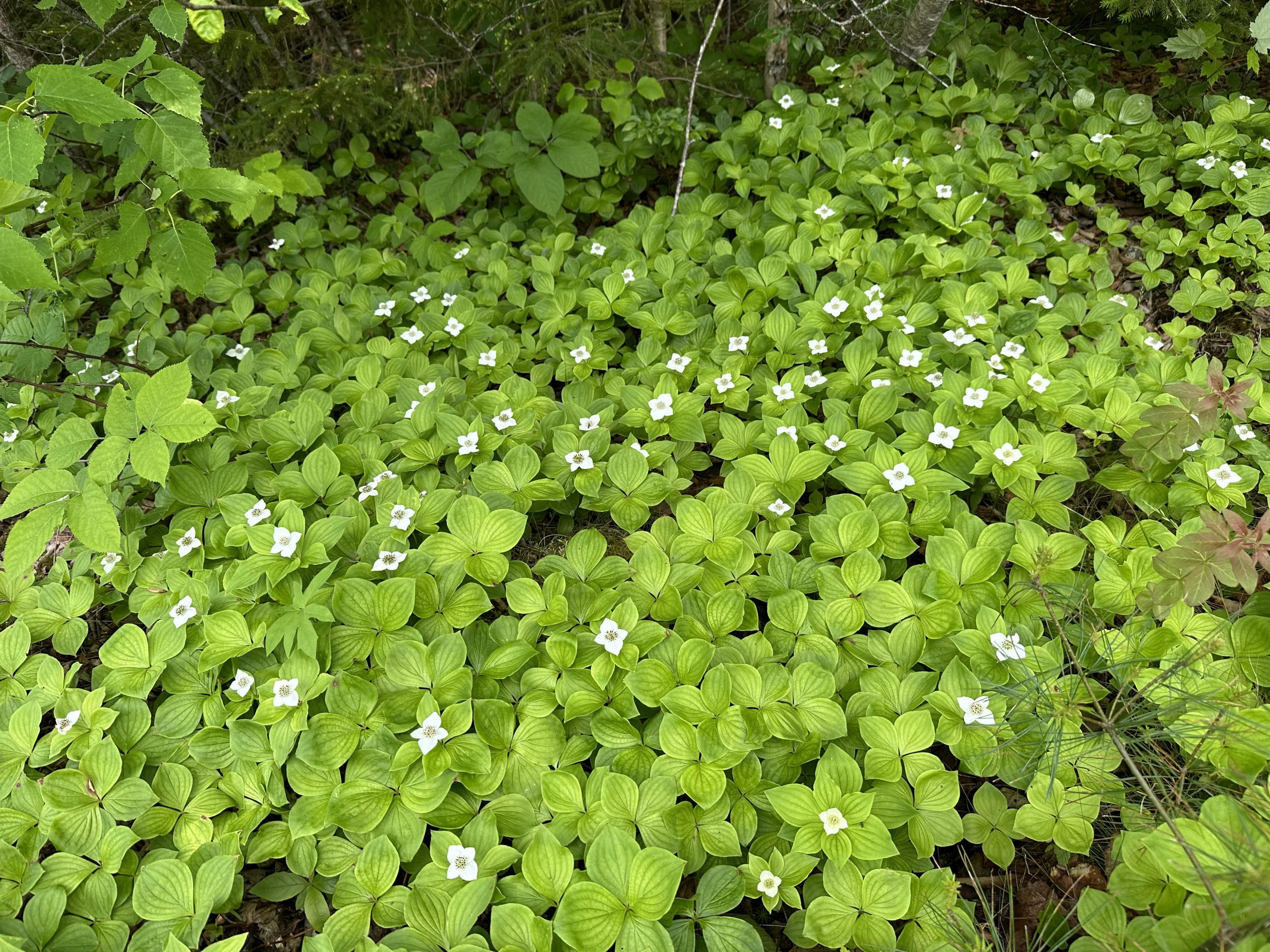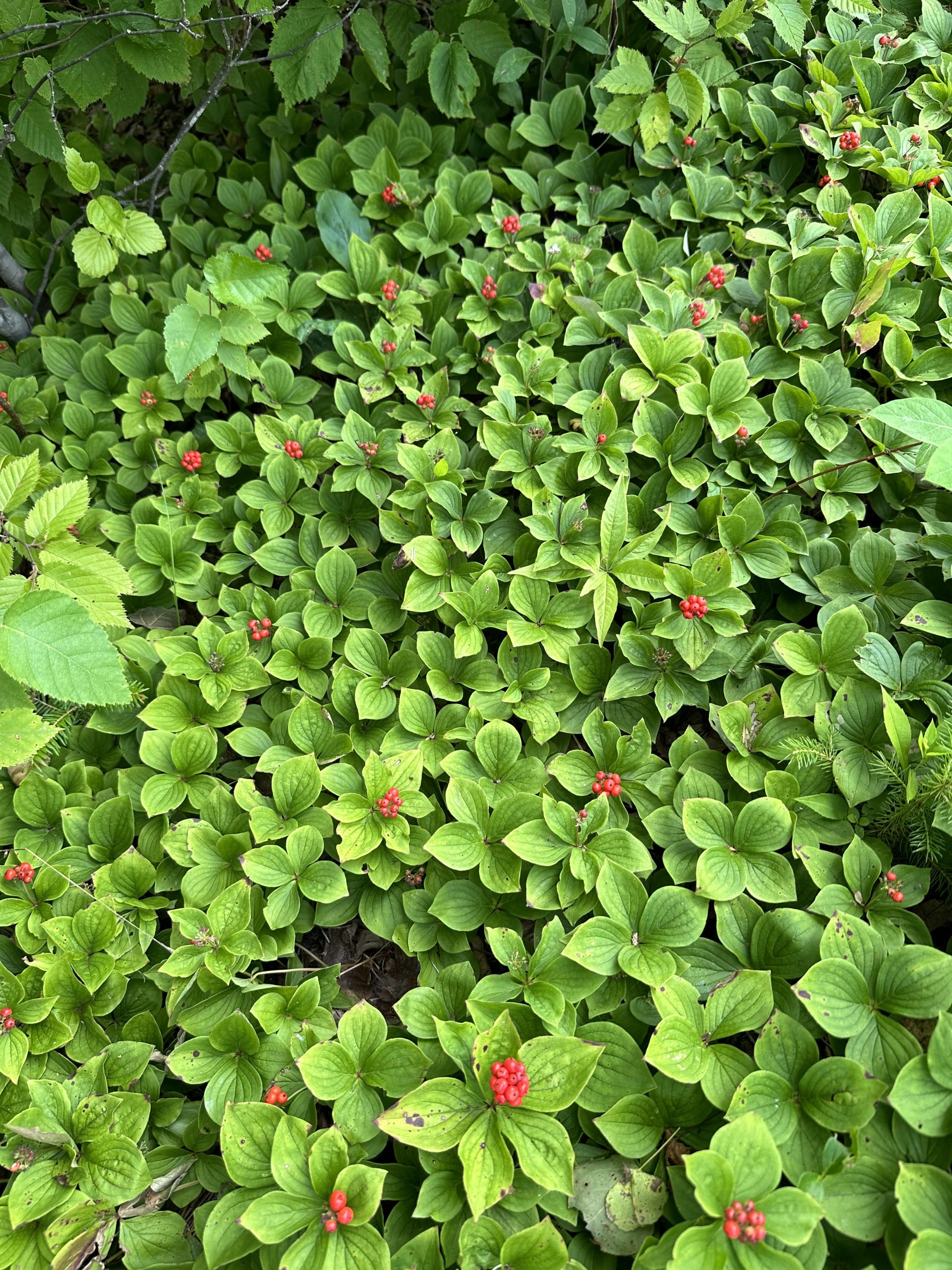Bunchberry Sod for Landscaping

Introduction
Looking to transform your shaded garden spaces into a thriving ecosystem?
Bunchberry (Cornus canadensis) stands out as a remarkable groundcover choice that combines aesthetic appeal with ecological value.
This native North American plant creates a lush carpet of green foliage, adorned with delicate white flowers in spring and vibrant red berries in fall. As a low-maintenance groundcover option, Bunchberry excels in shaded areas where many other plants struggle to establish.
Your garden benefits from Bunchberry’s presence in multiple ways:
- Creates habitat for local wildlife
- Supports native pollinators
- Provides year-round visual interest
- Helps prevent soil erosion
- Requires minimal maintenance
This guide explores the essential aspects of incorporating Bunchberry into your landscape design, including:
- Plant characteristics and identification
- Optimal growing conditions
- Ecological benefits
- Seasonal aesthetic appeal
- Design integration strategies
- Maintenance requirements
Discover how this versatile plant can enhance your garden’s beauty while contributing to local biodiversity.
What is Bunchberry?
Bunchberry (Cornus canadensis) is a unique member of the dogwood family, different from its larger, woody relatives. This perennial plant brings the beauty of dogwoods down to the ground, creating lush green carpets in forested areas.
Physical Characteristics
Bunchberry has a distinct physical structure that includes:
- Leaves: Whorled arrangement of 4-6 oval leaves, displaying prominent veining patterns
- Flowers: Small, greenish-white central flowers surrounded by 4-6 showy white bracts
- Berries: Bright red, edible drupes that form tight clusters
- Stems: Herbaceous and low-growing, emerging from underground rhizomes
Growth Habits
Unlike its taller dogwood relatives, Bunchberry only grows to about 3-8 inches in height, making it ideal for landscaping at ground level. The plant spreads through a network of underground stems, forming dense colonies in suitable environments.
Growth Cycle
Bunchberry follows a specific growth cycle:
- Spring emergence with fresh green foliage
- Late spring to early summer flowering
- Late summer berry development
- Fall color transformation to deep reds and purples
The plant’s small size and creeping growth pattern distinguishes it from traditional dogwoods. However, it still retains the family’s characteristic four-petaled flower structure and opposite leaf arrangement. This combination of familiar dogwood features in a low-growing form makes Bunchberry an intriguing addition to shaded gardens.
Ideal Growing Conditions for Bunchberry
Bunchberry plants thrive in specific environmental conditions that mirror their natural woodland habitat. These hardy perennials display optimal growth in part to full shade locations, making them perfect for areas that receive filtered sunlight through tree canopies.
Soil Requirements
The soil requirements for successful bunchberry growth include:
- Rich, organic matter content
- pH levels between 5.0 and 6.8 (acidic)
- Well-draining composition
- Consistent moisture retention
Creating the right soil environment means incorporating organic materials like:
- Pine needles
- Leaf mold
- Decomposed bark
- Peat moss
Moisture Management
Proper moisture management plays a crucial role in bunchberry health. The soil should remain consistently moist but never waterlogged. A 2-3 inch layer of organic mulch helps maintain ideal moisture levels while suppressing weed growth.
Temperature Considerations
Temperature considerations affect bunchberry’s performance. These plants prefer cool conditions and struggle in areas where temperatures consistently exceed 85°F (29°C). Providing adequate shade and maintaining proper soil moisture helps protect plants during warmer periods.
Root Establishment
Root establishment requires patience – bunchberry plants typically take 2-3 growing seasons to fully establish their root systems. During this period, maintaining consistent soil moisture proves essential for healthy growth and spread.
Ecological Benefits of Using Bunchberry in Landscaping Projects
Bunchberry plants create vibrant wildlife hubs in your garden landscape. These native groundcovers attract a diverse range of pollinators, including:
- Bees – Both native and honey bees visit the star-shaped flowers
- Butterflies – Adult butterflies feed on the nectar-rich blooms
- Moths – Night-flying pollinators drawn to the white flowers
- Hoverflies – Beneficial insects that help control garden pests
The plant’s dense foliage provides shelter for small wildlife and serves as a crucial host plant for several native moth species. Their caterpillars rely specifically on Bunchberry leaves for food and development.
Birds benefit from Bunchberry landscapes too. The bright red berries offer essential nutrition during fall migration and winter months. Common visitors include:
- Hermit Thrushes
- American Robins
- Cedar Waxwings
- Dark-eyed Juncos
Adding Bunchberry to your landscape strengthens local biodiversity. As a native plant, it forms natural relationships with indigenous wildlife species that have evolved alongside it for thousands of years. These connections create resilient garden ecosystems that support endangered pollinators and help preserve native wildlife populations.
The plant’s spreading nature also helps prevent soil erosion while creating microhabitats for beneficial insects and soil organisms. This underground network enhances soil health and supports surrounding plants, creating a self-sustaining garden environment.
Enhancing Landscape Design with Bunchberry’s Aesthetic Appeal Throughout the Seasons
Bunchberry transforms your garden with stunning visual displays across all seasons. In spring, delicate creamy white star-shaped flowers emerge, creating a carpet of blooms that brightens shaded areas. These four-petaled flowers stand proudly atop whorled leaves, adding dimension and texture to woodland gardens.
As summer fades, the true magic begins. The flowers give way to clusters of bright red berries that persist through fall and winter. These eye-catching fruits create striking contrast against the foliage, drawing attention to otherwise understated areas of your landscape.
The plant’s foliage puts on its own spectacular show. The glossy green leaves maintain their beauty throughout summer, then transform into rich brick red hues during autumn. This color transformation creates dramatic visual interest, especially when planted in mass groupings.
Design tip: Create dynamic garden compositions by:
- Planting bunchberry in drifts beneath deciduous trees
- Using it as a foreground plant for taller shade-loving perennials
- Combining it with plants featuring contrasting textures like ferns or hostas
- Incorporating it into rock gardens for year-round interest
The changing faces of bunchberry offer unique opportunities to craft evolving garden scenes. Its low-growing nature makes it perfect for woodland edge plantings, where you can fully appreciate its seasonal transformations from spring flowers to fall foliage and winter berries.
Incorporating Bunchberry into Your Landscape Design: Practical Tips and Considerations
Successful Bunchberry integration starts with strategic spacing. Plant individual specimens 8-12 inches apart to create a dense groundcover while preventing overcrowding. This spacing allows each plant to establish strong root systems and spread naturally.
Note: If Planting Bunchberry Sod, Plants will already be naturally spaced.
Planting Arrangement Tips:
- Create staggered patterns for natural-looking coverage
- Space plants closer (6-8 inches) for faster ground coverage
- Leave 2-3 feet between Bunchberry patches and aggressive species
- Install physical barriers against invasive plants like Japanese knotweed
Consider incorporating Bunchberry into:
- Woodland garden paths
- Shaded rock gardens
- Native plant collections
- Forest edge plantings
Group plants in odd numbers (3, 5, or 7) to create natural-looking clusters. This planting strategy mimics how Bunchberry grows in its native habitat and creates visually appealing garden designs.
Maintenance Tips For Healthy And Thriving Bunchberry Plants Over Time
Watering
Proper watering is crucial for bunchberry success. You’ll want to maintain consistently moist soil without waterlogging the roots. Here’s a simple watering guide:
- Spring/Summer: Water deeply once per week
- Hot/Dry Spells: Increase to 2-3 times weekly
- Fall/Winter: Reduce watering as temperatures drop
Pest Management
Your bunchberry plants need minimal pest management. These hardy natives resist most common garden pests like aphids and spider mites. Watch for signs of:
- Yellowing leaves
- Wilting stems
- Unusual spots or discoloration
Root Health
Root rot poses the main threat to bunchberry health. Prevent this by:
- Installing proper drainage
- Avoiding overwatering
- Maintaining air circulation between plants
Seasonal Care Schedule
Late Winter
- Remove dead foliage
- Clear debris around plants
- Check for winter damage
Spring
- Apply fresh mulch layer
- Trim any damaged stems
- Start regular watering routine
Summer
- Monitor soil moisture
- Remove competing weeds
- Watch for spreading runners
Fall
- Reduce watering frequency
- Leave fallen leaves as natural mulch
- Allow plants to enter dormancy naturally
Keep your plants compact by trimming sprawling stems in early spring. This encourages dense growth and maintains the desired groundcover appearance.
Sod vs. Individual Plants
Individual Plants
- More cost-effective for small areas
- Better control over plant spacing
- Easier to replace if needed
Sod Options
- Faster ground coverage
- Best for large-scale projects
4. Quality Indicators
- Bright green leaves
- Strong root system
- No yellowing or spots
- Multiple stems per plant
- Healthy soil mix

